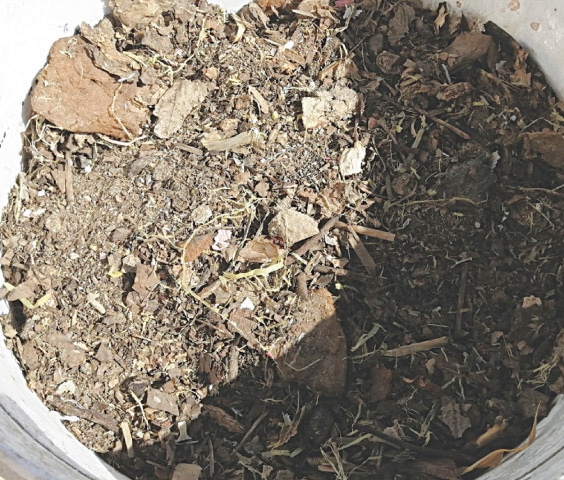
The three attractions for kitchen gardeners include having a continuous supply in-hand of comparatively fresh vegetables and herbs for their preparations, the produce being organic in nature and, of course, the price factor.
Cost effectiveness is fundamental for any kitchen gardener. Growing your own organic food may seem financially burdensome but, if done smartly, one may save a lot. Just like preparing food at home is a less expensive, healthier and ‘you know what actually goes inside the meal’ option, preparing food for your garden and plants is also less expensive and healthier, and you may tweak the ingredients as per your plant’s life-stage requirements. All you have to do is work intelligently and you can actually save a lot.
One of the vital foods for your growing greens is compost. Many types of compost are used, based upon the ease of availability of the ingredients, climate and temperature, plant requirements at different stages and many other factors.
The type of compost which we will be discussing today is one of the basic composts to begin with for any new gardener – the kitchen-scraps compost. The kitchen-scraps compost, as the name suggests, is made up of everything that you may actually throw away while preparing a meal. If you are a gardener who is incidentally the cook at your home as well, in-charge of the kitchen or simply have access to the kitchen of your home or any nearby restaurant or hotel, then be ready to start collecting scraps and preparing the Black Gold for your plants with your Midas touch.
If you are a gardener who has access to the kitchen of your home or any nearby restaurant, then be ready to start collecting scraps and preparing this valuable compost for your plants
Needless to say, apart from the container to collect these scraps and the specific place where they are kept, there are actually no other hidden charges to prepare this kitchen-scraps meal that plants would adore.
For those making kitchen-scraps compost for the first time, simply start collecting the peels of fruits and vegetables and discarded leaf stalks of herbs. Other than that, used tea leaves, coffee grounds, egg shells and even rotten fruits, vegetables and herbs all go into the compost preparation.
Similarly, every flour-based ingredient can also be used, including all types of breads and pastas. Discarded dairy products, including cheese, yoghurt, milk, butter, and all types of oils, including hydrogenated oil (ghee) should be strictly avoided from the compost preparation. All meat-based proteins, including fish, beef and mutton (and their scraps) should also be avoided if you are preparing the basic kitchen-based compost for the first time.

The ingredients that we have deliberately kept out of making kitchen-scraps composts for new gardeners are because of certain unavoidable factors. Firstly, elements such as oil and dairy produce a very unpleasant odour when used for composting. Secondly, these may attract rats, rodents and other unwanted pests, which might not be easy for beginners to handle.
These ingredients also tend to slow down the process of composting, which can be a demotivating factor for any eager gardener. Finally, the required ratio of the nutrients in the compost might get disturbed if the beginners put in over-enthusiastic and unrealistic quantities of one ingredient or another. The ratio, early on, might be difficult to handle for first-timers. This might not be the case after a few successive batches of compost, spread over a few seasons.
The ingredients that are okay to collect, including the peels and skins of fruits and herbs, are all part of the mixture that would eventually prepare only the green part of the kitchen-scraps compost. There is another equally significant brown part of the compost as well. Both of these parts should ideally be combined together to begin composting. The green part refers to the nitrogen-rich source while the brown part is rich in carbon.

The requirement for the brown part of compost is even easier to collect, ie if you want it to be from the inexpensive, throwaway products of your household. One may simply and easily collect papers, old newspapers, cardboards and dried shredded leaves for the brown part preparation.
Although, there are no specific measurable criteria generally when preparing compost, it is recommended to go for a 60:40 ratio. The green part (nitrogen source) at 60 percent and the brown part (carbon source) at 40 percent should be added together to prepare the kitchen-scraps-based compost. Mind you, reaching this equation is not as easy as it may sound. One simple trick is to simply check for odour. If the pile is rich in nitrogen, then the pungent, foul smell of ammonia formed from the nitrogen would be appreciable. Here, simply adding more ingredients to form the brown part would do the trick and help in equalising the compost ratio.
The temperature during composting should be between 30 and 65 degrees Celsius. If it is less than this range, there are high chances of slowing down the composting process. On the other hand, increased temperature may result in the death of the microorganisms that are the main forerunners of composting.
Composting is a slow, gradual process, and it tests your patience as microorganisms continue to convert the scraps into earthy-smelling, fine compost, depending upon a multitude of factors. We will continue to discuss the numerous aspects of composting in our upcoming articles.
Please send your queries and emails to doctree101@hotmail.com. The writer is a physician and a host for the YouTube channel ‘DocTree Gardening’ promoting organic kitchen gardening
Published in Dawn, EOS, July 9th, 2023
















































